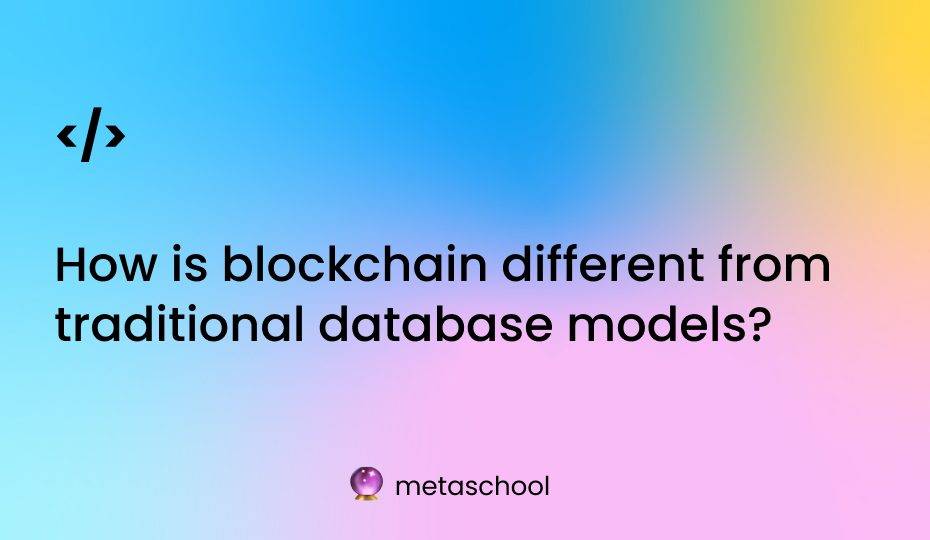Table of Contents
Here’s a quick answer explaining how is blockchain different from traditional database models. By the end of it, you’ll be able to tell both of them apart and confidently hold conversations as well as advance more deeply into your understanding of blockchain.
Blockchain is a decentralized, distributed system that allows multiple parties to maintain a shared database without relying on a central authority.
Traditional databases, on the other hand, are centralized systems that are typically managed by a single organization or entity.
Key differences between blockchain and traditional database models
1. Decentralization
The most significant difference between blockchain and traditional databases is that blockchain is a decentralized system. This means that there is no central authority controlling the network, and all participants have equal power and authority over the data. In contrast, traditional databases are typically controlled by a single organization or entity.
2. Immutability
One of the key features of blockchain is that the data stored on the network is immutable, meaning it cannot be changed or tampered with. This is achieved through the use of cryptographic techniques such as hashing and digital signatures. In contrast, traditional databases are often vulnerable to tampering, as they are controlled by a single entity or a small group of entities.
3. Consensus mechanisms
Blockchain technology uses consensus mechanisms to ensure that all nodes in the network agree on the state of the database. This allows the network to maintain a shared version of the truth, even in the presence of malicious actors. In contrast, traditional databases rely on a single entity or a small group of entities to maintain the integrity of the data.
4. Transparency
The data on a blockchain network is transparent, meaning that all transactions are publicly visible and can be audited by anyone. In contrast, traditional databases are typically protected by access controls and are not transparent by default.
5. Intermediary-less
Blockchain can operate as a peer-to-peer network, meaning that transactions can take place directly between parties without the need for intermediaries. This allows for increased efficiency and lower transaction costs. In contrast, traditional databases rely on intermediaries such as banks and other financial institutions to facilitate transactions.
Moving on, an example of a use case of blockchain technology would be a supply chain management system. In a traditional supply chain, goods are tracked using centralized databases that are managed by individual companies. This makes it difficult to get a complete picture of the supply chain, as the data is siloed and difficult to access.
A blockchain-based supply chain, on the other hand, would allow all participants in the supply chain to access and contribute to a shared, transparent record of the movement of goods.
Another example would be the use of blockchain in financial services. Blockchain technology can be used to create decentralized, peer-to-peer financial systems that do not rely on traditional intermediaries such as banks. This allows for increased financial inclusion, as well as lower transaction costs and increased efficiency.
Real-world examples of blockchain and traditional database models in comparison
1. Banking and finance
Blockchain technology is being used to create decentralized financial systems, such as Bitcoin and other cryptocurrencies. These systems allow for peer-to-peer transactions without the need for intermediaries such as banks.
Traditional banks, on the other hand, rely on centralized databases to manage their transactions and customer information.
2. Supply chain management
Blockchain technology is being used to create transparent and efficient supply chain management systems. For example, Walmart is using blockchain to track the movement of goods from farm to store, allowing for greater transparency and traceability.
Traditional supply chain management systems, on the other hand, rely on centralized databases that are managed by individual companies.
3. Identity management
Blockchain is being used to create decentralized, self-sovereign identity systems, such as uPort and Evernym. These systems allow individuals to control and manage their own personal information.
Traditional identity management systems, on the other hand, rely on centralized databases that are managed by governments and other organizations.
4. Land registry
In countries such as Ghana, Sweden and Ukraine, blockchain is being trialed as a solution for land registry. This allows for more transparency and security, as well as the ability for individuals to prove land ownership and streamlining the process of buying and selling land.
On the other hand, traditional land registry systems rely on centralized databases that are managed by government organizations, this can be vulnerable to corruption and can be prone to errors, leading to disputes.
5. Digital advertising
Furthermore, it is being used to create decentralized, transparent digital advertising networks, such as Brave and the Basic Attention Token. These systems aim to address issues such as fraud and the lack of transparency in traditional digital advertising systems, which rely on centralized databases.
In summary, these examples show how blockchain technology can be used to create decentralized, transparent, and efficient systems across various industries, while traditional database models are centralized, opaque and sometimes prone to errors and security issues.
